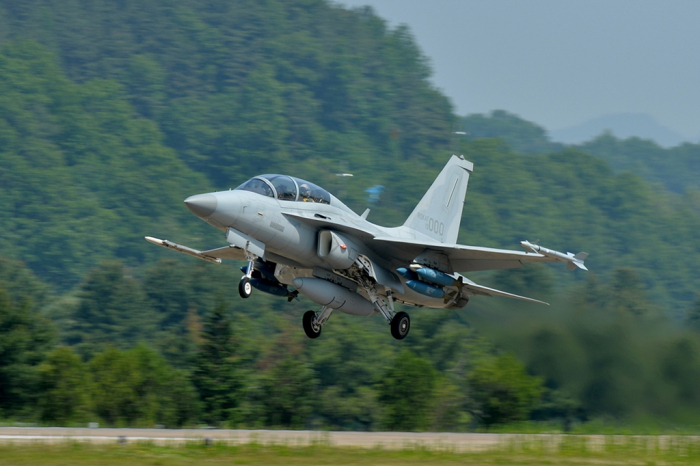Aerospace & Defense
Korean military aircraft maker KAI to spend $1.1 bn on R&D
The government aims to enhance export competitiveness in the aerospace sector, support next-generation system development
By Dec 12, 2022 (Gmt+09:00)
1
Min read
Most Read
LG Chem to sell water filter business to Glenwood PE for $692 million


Kyobo Life poised to buy Japan’s SBI Group-owned savings bank


KT&G eyes overseas M&A after rejecting activist fund's offer


StockX in merger talks with Naver’s online reseller Kream


Mirae Asset to be named Korea Post’s core real estate fund operator



Korea Aerospace Industries Ltd. (KAI), the country’s military aircraft manufacturer, is poised to invest 1.5 trillion won ($1.1 billion) in research and development by 2027 to address changes in future technologies, while the government aims to nurture the industry for more exports.
KAI on Dec. 9 held an annual meeting with contractors, the government and other authorities to seek measures for better competitiveness in the global markets and share strategies.
“We will enhance R&D capabilities of core technologies focusing on projects for new future growth engines,” said KAI CEO Kang Goo-young in an opening speech.
KAI, which inked a $3 billion deal in September to export light fighter jets to Poland, aims to sell the FA-50s to other countries such as Malaysia, Colombia and Egypt. The company is seeking to sell 1,000 units of the light combat aircraft worth 40 trillion won over the next decade.
GOVERNMENT SUPPORT
South Korea’s government plans to support the aerospace maker as the country aims to develop a future economic growth engine in the industry.
The country is predicted to export more than $20 billion in defense products by year-end, compared to some $7 billion in 2021.
The government plans to improve export competitiveness with the completed aircraft renovation business and support next-generation system development while nurturing private companies’ component businesses to enter the global supply chain, said Kim Bong-seok, head of the aerospace team at the Ministry of Trade, Industry and Energy.
The authority also aims to develop the ecosystem for the advanced air mobility (AAM) industry and improve related regulations, Kim added.
Write to Seo-Woo Jang at suwu@hankyung.com
Jongwoo Cheon edited this article.
More to Read
-
 Aerospace & DefenseKorea eyes $20 bn in weapons exports as Hanwha inks $6 bn Polish deal
Aerospace & DefenseKorea eyes $20 bn in weapons exports as Hanwha inks $6 bn Polish dealOct 20, 2022 (Gmt+09:00)
2 Min read -
 Aerospace & DefenseMalaysian officials to visit KAI plant for fighter jet deal
Aerospace & DefenseMalaysian officials to visit KAI plant for fighter jet dealOct 04, 2022 (Gmt+09:00)
2 Min read -
 Aerospace & DefenseKAI signs $3 bn fighter jet export contract with Poland
Aerospace & DefenseKAI signs $3 bn fighter jet export contract with PolandSep 19, 2022 (Gmt+09:00)
1 Min read -
 Aerospace & DefenseKAI targets to sell 1,000 units of FA-50 light attack aircraft worth $30 billion
Aerospace & DefenseKAI targets to sell 1,000 units of FA-50 light attack aircraft worth $30 billionJul 22, 2022 (Gmt+09:00)
3 Min read
Comment 0
LOG IN


